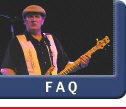Twenty-five years after the band called it quits, revered prog-rockers
Happy the Man are returning to record bins with The Muse Awakens.
And, of all places, that reunion is rooted in Baja, Mexico.
It
was at a prog-rock festival in Baja in 1999 when guitarist/vocalist
Stanley Whitaker was mobbed by scores of fans who freaked when they
discovered that a member of Happy the Man was in the house. "I was
swarmed by like 75 people from all over the world," Whitaker says.
"I was just floored. I was like, 'What the hell is this about?' I
was completely overwhelmed."
The band's demise was some 20 years in the past at that point. And
for all Whitaker knew, Happy the Man and its two experimental rock
albums for Arista Records had been pretty much forgotten about. "We
had no idea we had made an impact, no inkling," he says. To his
surprise, though, the eager fans regaled him with stories about the
band's presence on the Internet, and how interest in Happy the Man's
music is still very much alive.
What's more, one of those jazzed fans was a promoter for leading
U.S. prog-festival Nearfest, who offered Happy the Man a slot on the
following year's bill, providing of course that Whitaker could
revive the band.
Left virtually slackjawed by the experience Whitaker, who had for
years been dabbling in pop music to little avail, dialed up ex-bandmate
Frank Wyatt. Each of the members had kept in touch with one another
since their split in 1979, and Wyatt didn't hesitate at all. "I was
totally into it," Wyatt says. "There was nothing that I wanted to do
more in my life than play in Happy the Man. It's all I ever wanted
."
But not everyone was as eager. While bassist Rick Kennell was also
in, keyboardist Kit Watkins wasn't completely sold on the idea: He
was interested in a recording a follow-up to the band's second and
final album, 1978's Crafty Hands, but he didn't want to play
live. The others, meanwhile, were electrified by the idea of
reuniting onstage, and were looking ahead to Nearfest 2000, which
would prove the band's first gig.
Watkins' reluctance wasn't enough to keep a reunion from happening.
Long before he added Robert Palmer, Billy Joel and Whitesnake to his
long resume, celebrated keyboardist David Rosenthal had fallen in
love with Happy the Man and its albums, Crafty Hands and
Happy the Man, the group's 1977 debut. Through a friend, he met
Whitaker and Kennell while he was studying at the Berklee College of
Music in Boston, telling them how he had transcribed Kit Watkins'
solos and Happy The Man songs.
Rosenthal would keep in contact with Whitaker over more than two
decades. "Because I was friendly with them, I knew that there may be
a reunion, I knew what was going on. And I remember telling them
that if for any reason Kit doesn’t want to do it, I'd love to be a
part of it. I planted the seed, but I never thought anything would
come from it," Rosenthal says. Little did he know.
With drummer
Ron Riddle
temporarily rounding out the rhythm section, the band set out to
relearn the songs it hadn't played for more than two decades, blends
of classical and symphonic music, jazz and rock. Having practiced
tirelessly for five to six days a week when the band first formed in
the early 70s, the band members needed a little time to get their
chops back, Wyatt laughs, remembering the tough time he had with "Ibby
It Is" from Crafty Hands. Joe Bergamini was later chosen to
fill the drum chair. Bergamini
plays in the band for the Broadway musical "Movin' Out", the
instrumental rock/fusion band 4Front and he also performed in a Rush
tribute band called Power Windows.
Eventually, Whitaker moved in with Wyatt to begin writing songs.
"Just sitting in the room playing with Stan again, I felt like a kid
again. I felt like we were right there where we left off," Wyatt
says. Having struggled with his stabs at creating pop music with
integrity, writing had proved a somewhat difficult process for
Whitaker for years. But all that changed when Happy the Man
reunited: "It was so much easier, so much more natural. It literally
just poured right out of us. This music sort of writes itself." The
first song he wrote for The Muse Awakens was, appropriately,
the title track.
While the chemistry was still alive, Wyatt was also excited to take
advantage of the advances in technology that had happened in the
quarter century since the band last released an album. "We were able
to present our ideas better, with things like MIDI," he says. "More
of my parts could be realized, I was able to sketch them out in ways
that I couldn’t before."
The whole idea was to pick up where the other albums left off,
Rosenthal says. "We wanted to make the album sound current, but
still make sure it sounded like Happy the Man." And that was easy to
do: "When we play together, it sounds like Happy the Man. It really
wasn’t a chore to make it sound like Happy the Man. We just sound
that way when we play together."
Formed in a cramped dorm room at Madison College (now James Madison
University) in Harrisonburg, Va., in 1972,the original Happy the Man
made complex rock music steeped in classical structures, songs and
albums compared to those made by prog-rock giants Yes and Gentle
Giant.
When the likes of eventual Arista labelmate Santana were free-form
jamming, Happy the Man was doing anything but. While its songs could
be epic in length, compared to the standard pop song, the band's
largely instrumental music was structured and thought-out. And the
records were marked by the varying styles of the band's three
writers: Wyatt, Watkins and Whitaker.
"Those albums, the first two Arista albums, I put on a pedestal,"
Rosenthal says. "They are two of my favorite albums of all time. I
love the perfection, the melodicism, the virtuosity of the musicians
that wasn’t being thrown in your face in every bar. They could
deliver beautiful melodies as easily as they could break loose and
burn on rippin' solos. The production was amazing. They were great,
great sounding records. The arrangements and compositions were so
finely crafted. I had never heard anything so finely crafted outside
of the classical world. It was classically arranged, yet they’d use
jazz chords, interesting chords. They took chances harmonically, but
always in support of a strong melody.
"It's music that's hard to categorize," Rosenthal continues. "And
that was part of the difficulty, one of the problems they had back
then--nobody knew what to do with it, nobody knew how to market it."
Original members included vocalist Cliff Fortney and drummer Mike
Beck, but Happy the Man would lose the former before its bow on
Arista, and the latter would be replaced by future Blue Oyster Cult
skinsman Ron Riddle on their second album. While lauded critically,
Happy the Man's music was a bit of a conundrum for Arista, Whitaker
says: "They put us on tour with people like Hot Tuna, and I think
they only bought one print ad for our first record. We were making
music that we thought had substance, but we had no support from
Arista. Eventually, we were run over by the disco machine."
"We were all like 21, 22, 23, and were very bad about business," he
continues. "We had musical chops, but we had no business savvy, no
business chops at all."
Revisiting those bitter last days of the original band, and
pondering both the excitement for the band's music he encountered in
Baja, and the ensuing reunion, Whitaker says, "It feels like
validation. In a lot of ways, it's like we've come full circle.
We're able to make music in the Happy the Man style of old, music
full of integrity. In a lot of ways, it's more rewarding, more
fulfilling."
www.happytheman.com
www.insideoutmusic.com
For more information,
contact:
Chipster
Entertainment Inc.
1976 E. High St.
Suite 203 Pottstown,
PA 19464
fax: 610-323-7230
e-mail: info@chipsterpr.com
![]()











